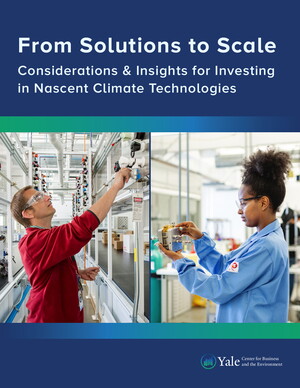From Solutions to Scale: Considerations and Insights for Investing in Nascent Climate Technologies

Executive Summary
New technologies can play a critical role in solving the climate crisis during the 21st century. When researchers map out scenarios of policies and actions that could avert the worst impacts of climate change, the success of these models often depends on the development of advanced technologies in areas such as renewable resources, energy efficiency and storage, and carbon removal. This report refers to such solutions as “nascent climate technologies.” Without innovation in these areas, addressing climate change will be far more difficult, if not impossible. The public and private sectors play a crucial role in developing nascent climate technologies by deploying capital to bring promising solutions to scale.
Traditional investing structures typically work best either early or late in the innovation process. Grants and public sector funding tend to support early-stage solutions through research and development, while venture capital and private equity tend to support commercialization and deployment. The messy middle, in-between these two periods—which typically includes demonstration and pre-commercialization—is often called the “valley of death,” because many new technologies struggle to stay funded through this phase. In practice, new technologies tend to face multiple valleys of death during this period, with potential shortfalls happening whenever they require a capital influx to move from one stage of innovation to another.
Gaps in funding often occur due to a combination of perceived outsized risk, large capital requirements, long development timelines, and other factors that are off-putting to market-rate risk investors. More risk-tolerant, patient investors—such as philanthropists, family foundations, high-net-worth individuals, and corporate venture capital—are stepping up to address these funding gaps, but some may lack the tools, resources, and relationships to deploy their capital in the most effective way. In particular, supporting nascent climate technologies requires high levels of coordination between actors across the technology development pathway, as well as an ability to navigate a diversity of financial, as well as non-financial, risks and uncertainties.
Distilling insights from over 20 interviews with professionals in the field, this report reviews key barriers to investing in nascent climate technologies and identifies useful considerations and insights when seeking to advance critical climate solutions. The interviewees for the report included investors, entrepreneurs, government agency representatives, philanthropists, foundations, incubators, accelerators, and universities. Based on these conversations and additional research, this report highlights five key areas for investors to consider when supporting nascent climate technologies:
- Improving collaboration and coordination among investors across multiple stages of technology development and investment types
- Strengthening the ecosystem of climate innovation across the investment landscape
- Building investor capacity to effectively evaluate, select, and fund nascent climate technologies
- Better aligning risk and return metrics with investor capabilities and start-up needs
- Enhancing non-financial support, such as expertise, partnerships, connections, equipment, and political advocacy






